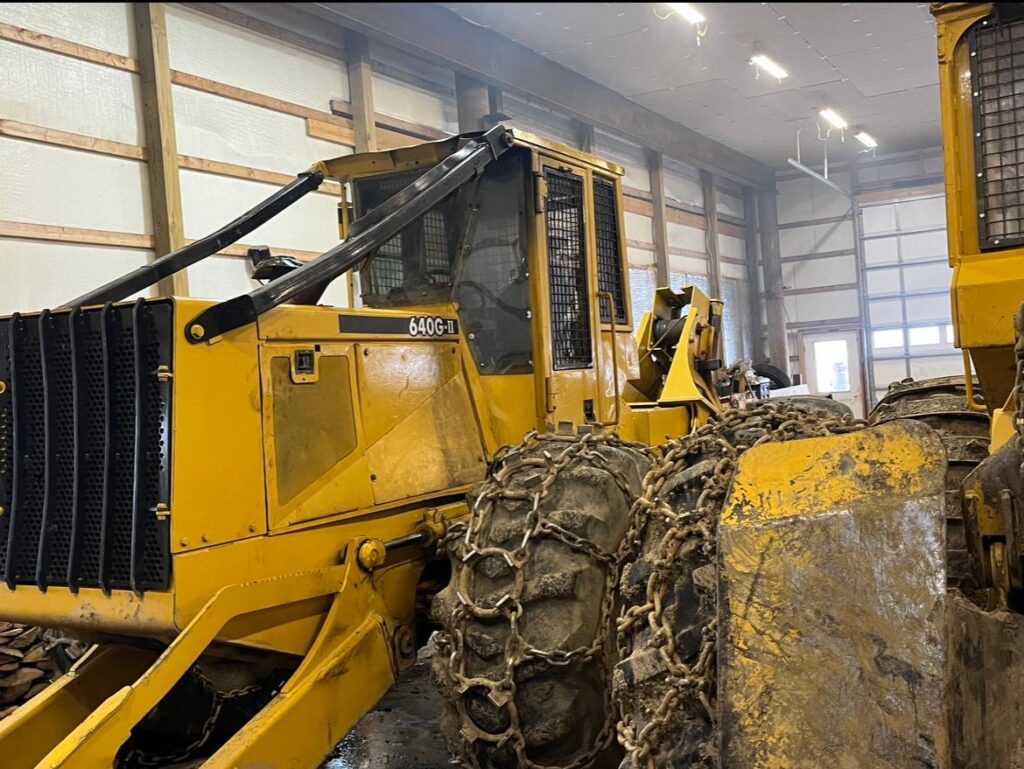Table of Contents Introduction: Why Sawmill Maintenance Matters Sawmill Maintenance Equipment List Sawmill Maintenance Guide: Daily, Weekly & Monthly Tasks What Are the Items to Be Included in Routine Maintenance? What Are the Basic Maintenance Procedures for a Sawmill? Conclusion: Keeping Your Sawmill Running Smoothly Key Takeaways: Sawmill maintenance extends machine lifespan and boosts productivity. […]
5 Essential Tips for Buying a Used Skidder: Your Comprehensive Guide
In the heart of forestry operations, the skidder stands as a steadfast workhorse, making logging and timber extraction possible. Whether you’re a seasoned logger or just stepping into the world of forestry, investing in a used skidder can be a smart move. However, with a plethora of used skidders for sale and potential pitfalls, navigating the process can be overwhelming. That’s where we come in!
In this article, we’ll equip you with the top five tips for buying a used skidder that aligns perfectly with your needs and budget.
5 Best Tips to Buy Used Skidder
Here are some tips that serve as a stepping stone toward a confident and well-informed decision. Equipped with these five crucial tips, you will be prepared to navigate the complex terrain of purchasing a used forestry skidder.
- Buy from a Reputable Dealer
- Know Your Needs
- Buy a Skidder Common in Your Area
- Thoroughly Inspect the Skidder
- Price Commensurate with the Going Value
1. Buy from a Reputable Dealer: Assurance Amidst Choices
Before embarking on your skidder-buying journey, pause to consider the importance of choosing the right dealer. Opt for reputable dealers with a track record of reliability and excellent customer reviews. This step ensures you’re not only getting a quality machine but also investing in a seamless purchasing experience. Additionally, inquire about any warranties or guarantees the dealer offers. These safeguards can provide you with peace of mind as you step into the world of used skidders.
2. Know Your Needs: Tailoring the Skidder to Your Projects
Every forestry project is unique, demanding a skidder that aligns with your specific requirements. Begin by assessing the tasks and projects the skidder will tackle. Determine the necessary horsepower, size, and capacity to power through your operations efficiently. Don’t forget to consider any distinctive features or attachments that could enhance your productivity. For more detailed insights into skidder types and operations in forestry and logging, be sure to check out our companion article.
3. Buy a Skidder Common in Your Area: Local Wisdom Matters
The forestry landscape varies from region to region, and so does the availability of parts and services. Opting for a commonly used skidder model in your area can offer several advantages. Not only might you benefit from better support, but you’ll also enjoy easier access to spare parts. Before making a decision, consult with local operators or experienced loggers. Their insights can guide you toward popular and reliable skidder models that have proven their worth in the field.
4. Thoroughly Inspect the Skidder: Uncover Hidden Gems and Pitfalls
A thorough inspection is the cornerstone of a successful used skidder purchase. Before finalizing any deal, carefully examine the engine, transmission, and hydraulic systems for any signs of leaks or issues. Pay close attention to the undercarriage, tires, and tracks for wear and tear, as these components are essential for smooth operations. Don’t forget to test all functions and controls, including the blade and winch (if applicable). This meticulous inspection ensures you’re not inheriting unexpected problems.
5. Price Commensurate with Going Value: Ensuring a Fair Deal
Pricing can be a tricky aspect of buying a used skidder. To avoid overpaying or settling for less, it’s crucial to research the current market value of the skidder model you’re interested in. Take into account factors like age, usage hours, condition, and any included attachments. To get a better perspective, compare prices from different sellers. This practice will empower you to negotiate confidently and secure a deal that aligns with the skidder’s true value.
6. Additional Tip: Seek Expert Advice
In the world of used skidders, the value of experience cannot be overstated. Don’t hesitate to consult with seasoned loggers or forestry professionals for their valuable insights and recommendations. Their firsthand knowledge can shed light on the potential pros and cons of different models. For technical aspects, seeking advice from mechanics or technicians well-versed in skidders can help you make an informed choice. Remember, harnessing the power of collective wisdom can set you on the path to a successful purchase.
Conclusion
As you embark on the journey to acquire a used skidder, keep these five essential tips at the forefront of your decision-making process. Buying a used skidder doesn’t have to be a daunting endeavor; armed with knowledge, you can make a confident and informed choice. Remember, the foundation of a fruitful purchase lies in selecting a reputable dealer, understanding your unique needs, considering regional factors, conducting thorough inspections, and ensuring a fair price.
And when it comes to a trusted source for used forestry equipment, look no further than Lumbermensco.com. Our commitment to quality and customer satisfaction ensures that your journey to finding the perfect skidder is both enjoyable and rewarding. Armed with these insights and supported by a reliable dealer, you’re ready to embark on this exciting journey. So go ahead, check out the used cable skidders or gripple skidders in good condition listed on our website, and unlock a new level of efficiency and productivity in your forestry endeavors.





